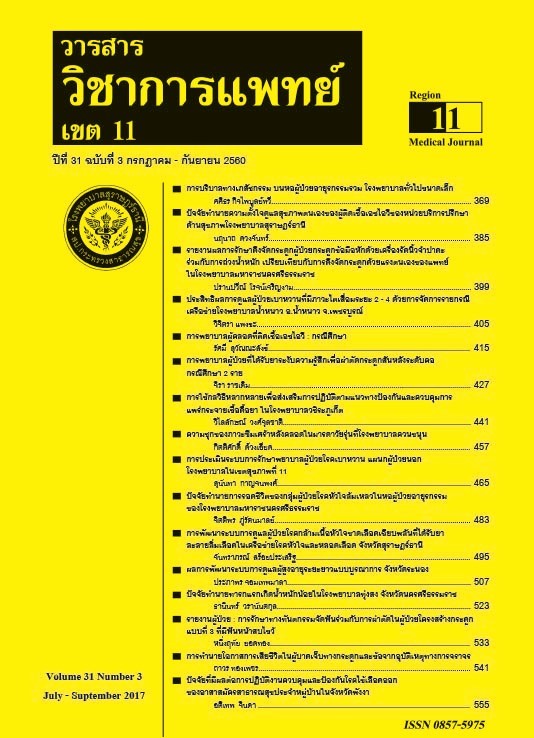Predictive Factors on Intention to Health Self Care for HIV Client in Counseling Department, Suratthani Hospital
Keywords:
behavioral intention, self-care behaviors of people infected with HIV, multiple regression equation.Abstract
This research study analyzes the relationship. To predict the intention of self health care of people infected with HIV of health advisory services Suratthani Hospital. Using a cross-sectional study (Cross sectional study) in people infected with HIV. Registered and counseling at the Medical service. Suratthani Hospital selected sample criteria from October 2559- December 2559 under the number 100 is allowed to carry out research by the hospital ethics committee. Surat then collected by questionnaire with a Gauges Top 5 on the belief about the behavior of self care of people infected with HIV, five on each side, 6 quality monitoring tools. Cronbach’s alpha coefficient that higher than 0.75 Analyzed by a computer program. Statistical correlation coefficient Pearson and multiple regression equation (Enter).
The study indicated that Sample People infected with HIV and 100 people are believed to include the self-care behaviors of people infected with HIV. The average high in five areas: attitude toward behavior (27.87 SD 2.44) subjective norms (26.86 SD 3.30) and the perceived behavioral controls (26.81 SD 3.16), as well as behavioral intention (27.01 SD 2.93). and behavior of the group (22.84 SD 5.21) faith behavior. That the perceived behavioral controls is associated with behavioral intention at the level of statistical significance was found that efficacy in controlling behavior. Weight relationships Behavioral intention highest (r = .743, p <0.01), followed by the subjective norms (r = .604, p <0.01), and the behavior (r = -. 553, p <0.01). and predict behavioral intention, with a significance level (R) is equal. 761, which shows that independent variables could explain the variance of the dependent variable was 58.0% (R2 = .580), according to the hypothesis. These results suggest that perceived behavioral control weight prediction intent on self care of people infected with HIV, the highest result of 57.8 (beta = - 0.578) and found that behavioral intention and. perceived behavioral control can predict self-care behaviors of people infected with HIV have a significant percentage of 47.8 (p <.01) percent and 20.0 (p <.05), according to the framework.
The results of such research The findings should lead to development of counseling. Skill in communicating with patients by providing the initial consultation and advanced applications in the peer group. Health care for the same disease. The research was to be a qualitative study together to find the depth to predict self-care behaviors of people infected with HIV and AIDS.
References
2. สุชาดา คงแก้วและคณะ. (2550). การประเมินความเครียด และวิธีเผชิญความเครียด ของผู้ติดเชื้อเอชไอวี/เอดส์ ในแผนกโรคติดเชื้อ โรงพยาบาลพระมงกุฎเกล้า.สืบค้นจาก https://www.tci-thaijo.org/index.php/JRTAN/article/viewFile/.../14288 ( 2559, ตุลาคม, 12 )
3. เบญจพร พงศ์อำไพ .(2552). ปัจจัยทำนายความตั้งใจของคู่สมรสหญิงตั้งครรภ์ในการมาใช้บริการตรวจคัดกรองเพื่อหาการติดเชื้อเอชไอวี . วิทยานิพนธ์ปริญญาพยาบาลศาสตรมหาบัณฑิตสาขาการพยาบาลผู้ใหญ่คณะพยาบาลศาสตร์มหาวิทยาลัยสงขลานครินทร์.วารสารสภาการพยาบาล 2552; 24(4) 70-82.
4. พุทธวรรณ ศิวเวทพิกุล.(2550) .พฤติกรรมการดูแลตนเองของผู้ติดเชื้อเอชไอวี หรือผู้ป่วยเอดส์ที่ได้รับยาต้านไวรัส. Journal of Nursing Science Naresuan University 2,1:40-51
5. สุพัตรา คงปลอดและคณะ. (2557). การรับรู้ความต้องการการดูแลตนเองและพฤติกรรมการดูแลตนเองของผู้ป่วยเอดส์ที่ติดเชื้อฉวยโอกาสวิทยานิพนธ์พยาบาลศาสตรมหาบัณฑิต (การพยาบาลผู้ใหญ่) โรงเรียนพยาบาลรามาธิบดี คณะแพทยศาสตร์โรงพยาบาลรามาธิบดี มหาวิทยาลัยมหิดล.
6. Ajzen, I. (1985). From intentions to actions: A theory of planned behavior. In J. Kuhl & J. Beckmann (Eds.), Action-control: From cognition to behavior (pp. 1 l-39). Heidelberg: Springer.
7. Ajzen, I (1991) .The Theory of Planned Behavior .ORGANIZATIONAL BEHAVIOR AND HUMAN DECISION PROCESSES 50, Copyright 0 1991 by Academic Press, Inc. 179-211 .
8. Cronbach, Lee J. 1970. Essential of Psychological Testing. 3rd ed. New York : Hazper & Row.
9. ฟูซียะห์ หะยี และสุไฮดาร์ แวเตะ (2555) .การดูแลสุขภาพตนเองในการป้องกันการแพร่กระจายเชื้อของผู้ติดเชื้อเอชไอวีและผู้ป่วยเอดส์ในสามจังหวัดชายแดนใต้.
10. วงศา เลาหศิริวงศ์. (2552 ). การประเมินการสร้างเสริมสมรรถนะแห่งตนในผู้ป่วยเอดส์ที่ได้รับการรักษาด้วยยาต้านไวรัสเอดส์: สภาพการณ์ปัจจุบัน(The Evaluation of Self-Efficacy Promotion of AIDS Patients Receiving Antiretroviral Therapy: Current Situation).
11. อรดี โชติเสน, สุรเดช ประดิษฐบาทุกา, อารี ชีวเกษมสุข.(2558). ปัจจัยที่มีความสัมพันธ์กับพฤติกรรมสุขภาพของผู้ติดเชื้อเอชไอวี/เอดส์กรณีศึกษาโรงพยาบาลสิรินธร สังกัดสำนักการแพทย์ กรุงเทพมหานคร วารสารพยาบาลทหารบกปีที่ 16 ฉบับที่ 1 (ม.ค. - เม.ย.) 2558 Volume 16 No.1 (Jan - Apr) 2015
12. ภูริชญา บุรินทร์กุล. (2550) .การดูแลตนเองของผู้ติดเชื้อเอชไอวี หรือผู้ป่วยเอดส์ที่ได้รับยาต้านไวรัส.วิทยานิพนธ์พยาบาลศาสตร์มหาบัณ ฑิต คณะพยาบาลศาสตร์ มหาวิทยาลัยเชียงใหม่.
13. สุลีมาศ อังศุเกียรติถาวร. (2553).วารสารพฤติกรรมศาสตร์เพื่อการพัฒนาปีที่ 2 ฉบับที่ 1 มกราคม 2553 ISSN 2228945343 ตัวแปรที่เกี่ยวข้องกับพฤติกรรมการดูแลสุขภาพตนเองของเด็กและเยาวชนที่ติดเชื้อเอชไอวีที่มารับริการตรวจรักษาในโรงพยาบาลภาครัฐเขตกรุงเทพมหานคร และปริมณฑล.
14. ธนภร สนิทอินทร์. (2552). พฤติกรรมการดูแลตนเองของผู้ติดเชื้อเอดส์ที่เข้าร่วมโครงการรับยาต้านไวรัสเอดส์ในโรงพยาบาลชุมชน จังหวัดอุบลราชธานี. วิทยานิพนธ์หลักสูตรสาธารณสุขศาสตรมหาบัณฑิต สาขาวิชาการสร้างเสริมสุขภาพ บัณฑิตวิทยาลัย มหาวิทยาลัยราชภัฏอุบลราชธานี.
15. Voss, J. G., Dodd, M., Portillo, C., & HolZemer, W. (2006). Theories of fatigue: Application in HIV/AIDS. Journal of the Association of Nurses in AIDS Care, 17, 37-49.
16. พูลสุข เจนพานิชย์ วิสุทธิพันธ์. (2555).Rama Nurs J January - April 2015Vol. 21 No. 1.ปัจจัยทำนายพฤติกรรมและความตั้งใจในการใช้ถุงยางอนามัยของผู้ติดเชื้อเอชไอวี/ผู้ป่วยเอดส์กับคู่ครอง/คู่นอน.






